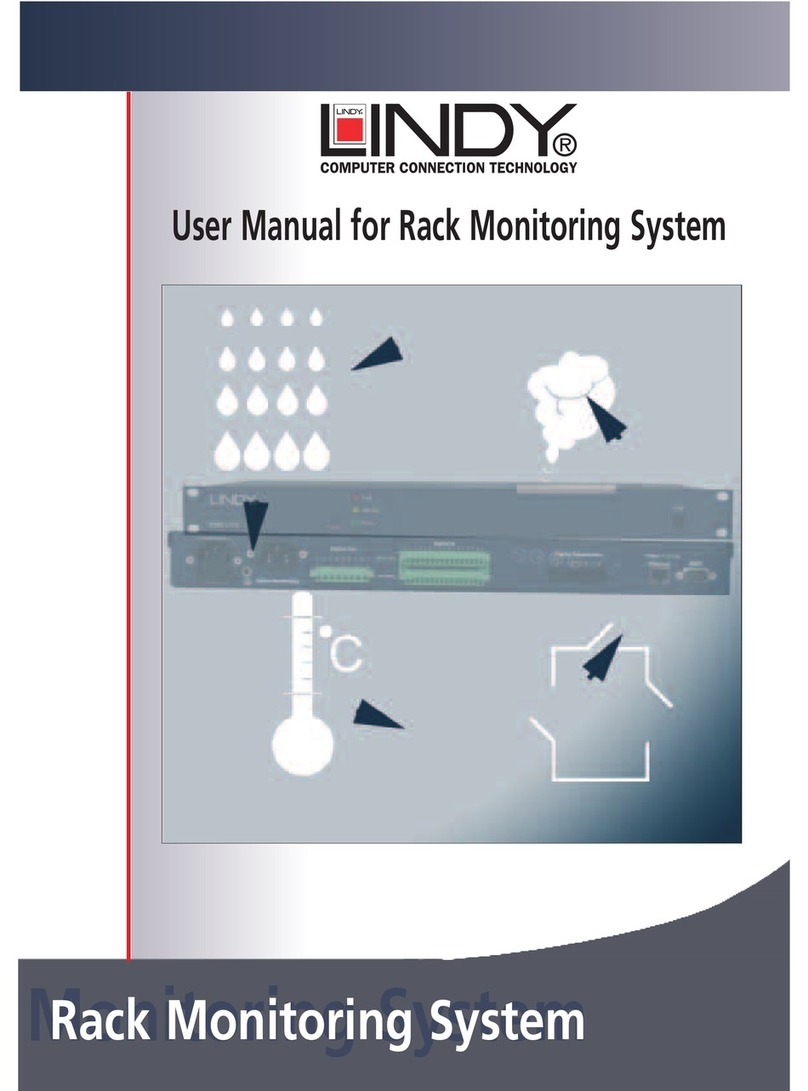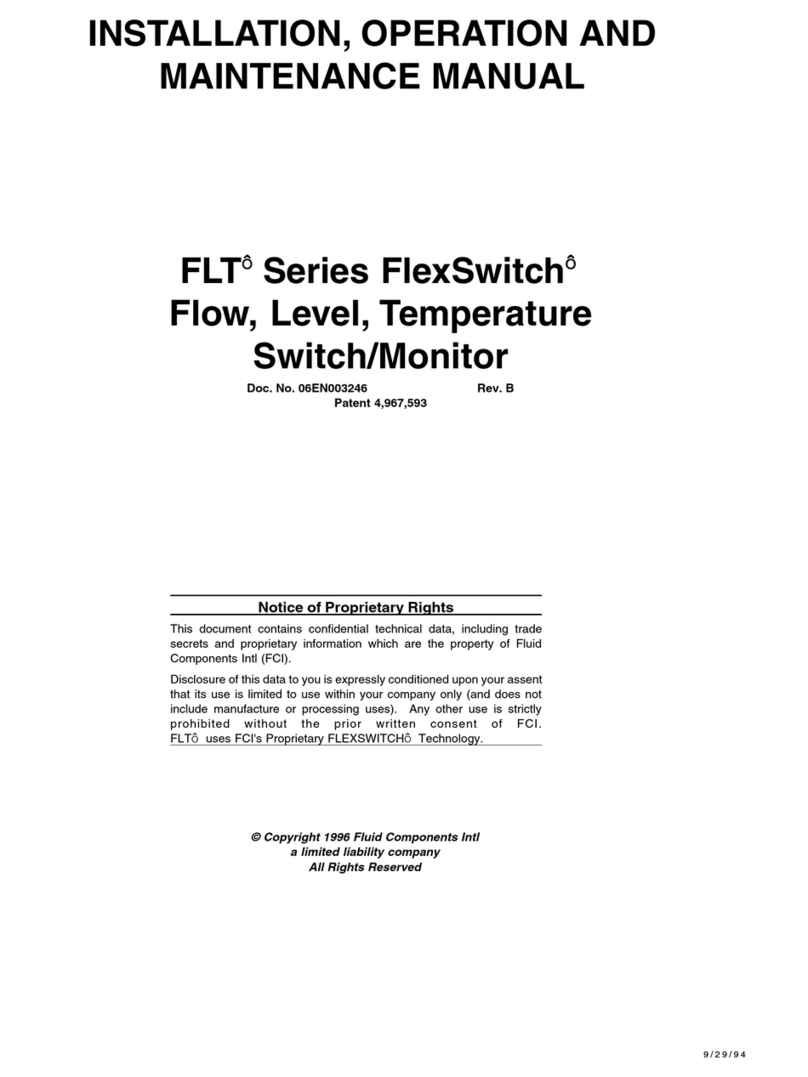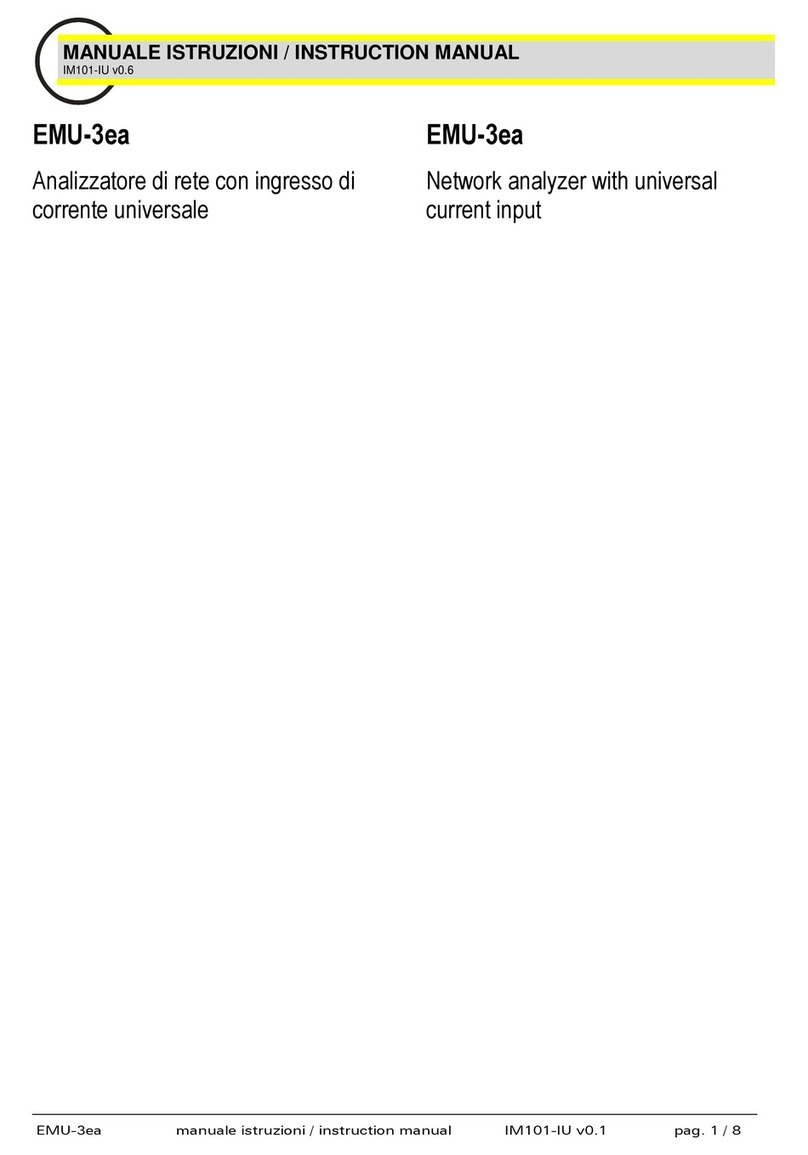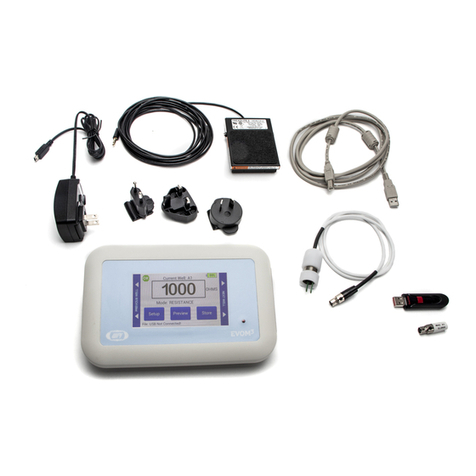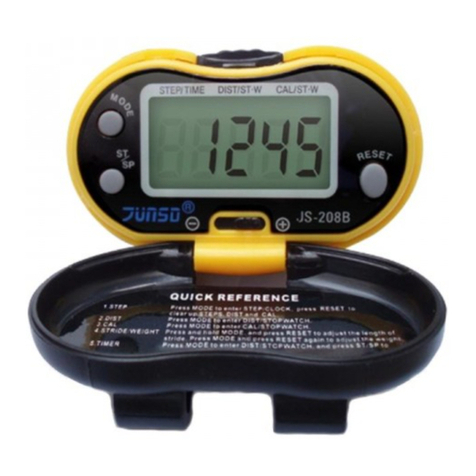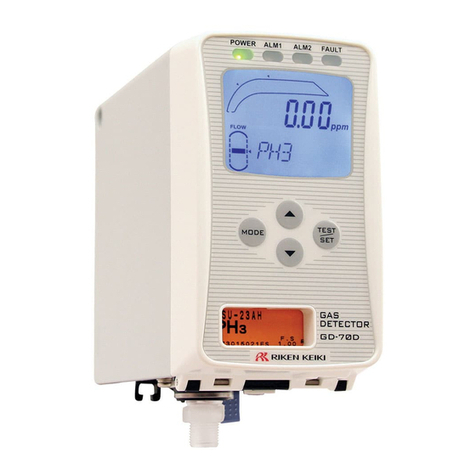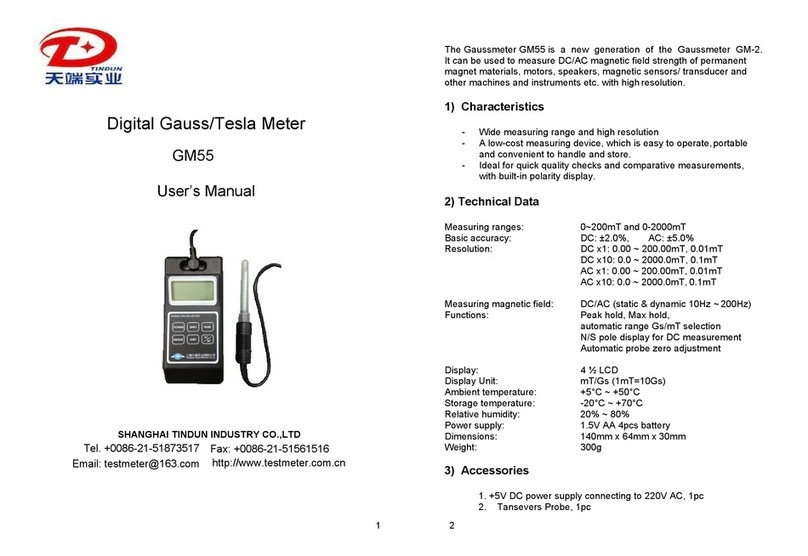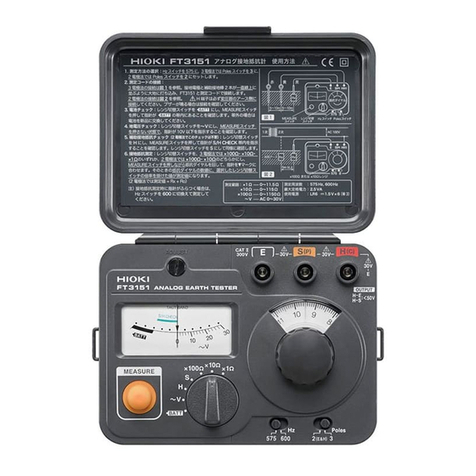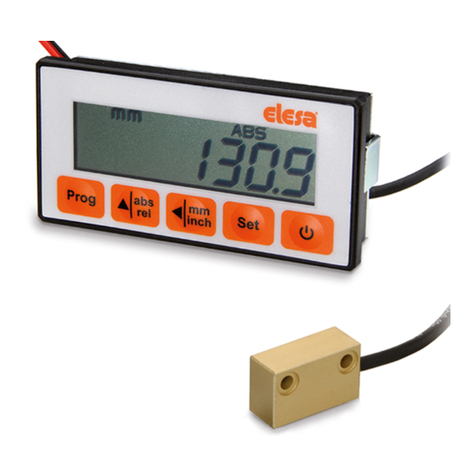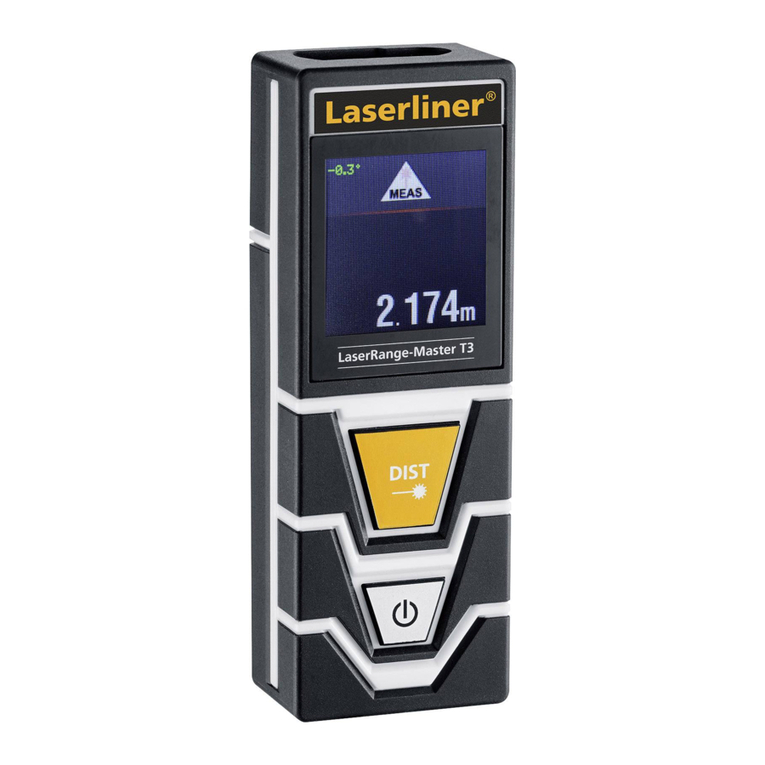Green G7000 User manual

PART NUMBER: 03135
G7000 OPERATION MANUAL
CONTINUOUS EMISSION MONITORING SYSTEM


CEMS
Version 2.7 – Revision February 2021 3
Content
1INTRODUCTION..................................................................................................6
1.1 ABOUT THIS MANUAL ........................................................................................................ 6
1.2 INQUIRIES AND FEEDBACK................................................................................................. 7
1.3 ABOUT THE SYSTEM ......................................................................................................... 7
2SPECIFICATIONS................................................................................................9
3SAFETY ASPECTS ...........................................................................................11
4MENU STRUCTURE ..........................................................................................14
4.1 HOME ............................................................................................................................ 15
4.2 PROBE 1 - 5................................................................................................................... 15
4.3 LOG............................................................................................................................... 16
4.4 LOGIN............................................................................................................................ 18
4.5 STATUS.......................................................................................................................... 18
4.5.1 IO Status ......................................................................................................... 21
4.5.2 Manual Operating System Components......................................................... 24
4.5.3 Reset system .................................................................................................. 24
4.6 SETUP ........................................................................................................................... 24
4.6.1 Probe setting................................................................................................... 26
4.6.2 CO2 Low Alarm............................................................................................... 26
4.6.3 Alarm setting ................................................................................................... 27
4.6.4 Auto Calibration Setting .................................................................................. 27
4.6.5 Average Settings............................................................................................. 28
4.6.6 Change Password........................................................................................... 29
4.6.7 Change PLC IP address ................................................................................. 29
4.6.8 HMI Screen Setting......................................................................................... 30
5COMMISSIONING .............................................................................................31
5.1 PROBES......................................................................................................................... 31
5.2 HEATED SAMPLE LINES ................................................................................................... 31
5.3 MONITORING CABINET .................................................................................................... 32
5.4 INITIAL LEAK TEST BEFORE OPERATION............................................................................. 32
5.5 MOUNTING THE PROBE TUBES......................................................................................... 33
5.6 GAS FLOW ADJUSTMENT ................................................................................................ 33
6CALIBRATION & VALIDATION ............................................................................35
6.1 AUTO AND MANUAL CALIBRATION WITH INTERNAL CALIBRATION CELLS.............................. 35
6.2 ANNUAL CALIBRATION & VALIDATION ROUTINE WITH TEST GASES.................................... 36
6.2.1 Calibration & Validation................................................................................... 36
7OPERATION ....................................................................................................38
7.1 OPERATING THE CEMS .................................................................................................. 38
7.1.1 Air Conditioner ................................................................................................ 38
7.2 LEAK TEST ..................................................................................................................... 39

Content
4
8ROUTINE MAINTENANCE ................................................................................. 40
8.1 PLANNED MAINTENANCE PROGRAM .................................................................................41
8.2 AIR CONDITIONER............................................................................................................43
8.2.1 Preventative Maintenance ...............................................................................43
8.2.2 Air Filter Service ..............................................................................................43
9SPARE PARTS ................................................................................................ 45
10 PACKING OF GAS ANALYZER........................................................................... 52
10.1 PACKING ........................................................................................................................52
11 APPENDIX ...................................................................................................... 53
11.1 TECHNICAL DOCUMENTATION LIST ...................................................................................53
12 MAINTENANCE & TROUBLESHOOTING .............................................................. 54
IG-G7000-001 ................................................................................................................58
IG-G7000-002 ................................................................................................................60
IG-G7000-003 ................................................................................................................61
IG-G7000-004 ................................................................................................................62
IG-G7000-005 ................................................................................................................65
IG-G7000-006 ................................................................................................................66
IG-G7000-011.................................................................................................................67
IG-G7000-012 ................................................................................................................68
IG-G7000-013 ................................................................................................................70
IG-G7000-014 ................................................................................................................72
IG-G7000-017 ................................................................................................................74
IG-G7000-018 ................................................................................................................77
IG-G7000-019 ................................................................................................................79
IG-G7000-020 ................................................................................................................81
IG-G7000-021 ................................................................................................................82
IG-G7000-022 ................................................................................................................87
IG-G7000-023 ................................................................................................................92
IG-G7000-029 ................................................................................................................95

CEMS
Version 2.7 – Revision February 2021 5
Table of Figure
FIGURE 4-1: HOME MENU SCREEN...................................................................................................14
FIGURE 4-2: HOME ..........................................................................................................................15
FIGURE 4-3: PROBE 1 – PROBES AND ANALYZING CABINET IN MEASURING STATE .................................16
FIGURE 4-4: PROBE 1 – PROBES AND ANALYZING CABINET IN HEATING STATE......................................16
FIGURE 4-5: SO2 LOG SCREEN .......................................................................................................17
FIGURE 4-6 STATUS PAGE IN MEASURING MODE ...............................................................................19
FIGURE 4-7 ALARM LIST OVERVIEW..................................................................................................20
FIGURE 4-8: IO STATUS ...................................................................................................................22
FIGURE 4-9 RESET THE SYSTEM ......................................................................................................24
FIGURE 4-10: SETUP SCREEN ..........................................................................................................25
FIGURE 4-11 DEFAULT SETUP ..........................................................................................................25
FIGURE 4-12 CUSTOMIZED EXAMPLE................................................................................................25
FIGURE 4-13 PROBE SETUP.............................................................................................................26
FIGURE 4-14 CO2 LEVEL ALARM......................................................................................................26
FIGURE 4-15 ALARM SETUP .............................................................................................................27
FIGURE 4-16 AUTO CALIBRATION SETUP ..........................................................................................27
FIGURE 4-17 AVG MOVE SETTINGS................................................................................................28
FIGURE 4-18 T90 GRAPH FOR 200 PPM SO2 GAS .............................................................................28
FIGURE 4-19 CHANGE PASSWORD ...................................................................................................29
FIGURE 4-20 CONFIRM PASSWORD ..................................................................................................29
FIGURE 4-21 CHANGE PLC IP ADDRESS ..........................................................................................29
FIGURE 4-22 HMI SCREEN SETTING.................................................................................................30
FIGURE 5-1 REMOVE THE SEALED PLUG............................................................................................33
FIGURE 5-2: GAS FLOW ADJUSTING ..................................................................................................34
FIGURE 6-1 FLOW CHART OF REQUIRED STEP FOR VALIDATION AND CALIBRATION ...............................37
FIGURE 8-1: PLANNED MAINTENANCE PROGRAM FOR THE G7000 CEMS SYSTEM.............................43
FIGURE 10-1 ANALYZER HOSE CONNECTIONS....................................................................................52

Introduction
6
1Introduction
1.1 About this Manual
This manual contains data and instructions for the operation and maintenance of the G7000
Continuous Emission Monitoring System (CEMS). For the installation of the CEMS,
please refer to the installation manual.
The instructions have been made in general terms and do not take into consideration a
specific installation. Therefore, this manual should be seen as a general guideline. As such,
the manual is designed only for the CEMS. The instructions for the operation and
maintenance of the complete monitoring system will be discussed in this manual.
The manual does not describe all possible situations but only the most common and known
situations and cannot replace the necessary education of the personnel. Should situations
not described in the manual occur, which cannot be solved in accordance with normal
known practice and good workmanship, the operator should contact Green Instruments
A/S for instructions.
Attention
Before operation read all instructions and warnings within this manual and associated
documentation. Improper use may cause personal injury and/or damage of equipment
and may void the warranty. Green Instruments A/S disclaims any responsibility for
damage and/or injury caused by improper installation, use or maintenance of the
equipment.
Green Instruments A/S reserves the right to alterations and improvements owing to
developments without being obliged to enter the corresponding changes in this manual.
Green Instruments A/S reserves the copyright of the manual. Without prior written
permission from Green Instruments A/S, the manual may not be copied and given to
unauthorized people.

CEMS
Version 2.7 – Revision February 2021 7
1.2 Inquiries and Feedback
All claims and inquiries for spares shall be addressed to Green Instruments A/S or our
distributors. In all correspondence or when ordering spare parts, please carefully state the
equipment type and serial number, which can be found on the label of the equipment.
Green Instruments A/S appreciates all feedback and suggestions for improvement. If you
have any questions or find any errors in the manual, you are welcome to contact us at the
following address:
Green Instruments A/S
Erhvervsparken 29
DK-9700 Brønderslev
Denmark
Phone:
Fax:
+45 9645 4500
+45 9645 4501
E-mail:
Web:
www.greeninstruments.com
1.3 About the System
The modular design of the CEMS makes it possible to monitor different gases according
to customer specifications. The G7000 can monitor the SO2 and CO2 concentrations in
exhaust gas according to the requirements in IMO regulations – NOx Technical Code 2008
and the requirements in MEPC.259(68). It provides an accurate measurement of SO2 in
ppm, CO2 in percent and the SO2/CO2 ratio, and presents these values on both the HMI
and Modbus TCP for logging and customer processing.
The system consists of a sampling and sample conditioning system and -up to two Multigas
Analyzers.
The unique double sample conditioning unit prepares the next sample simultaneous with
measuring from the current sample and hereby ensures a fast response time. This unique
feature allows the system to sample from up to 5 different sample points per system via
the multiplexing device.
Furthermore, the system uses an air conditioner to maintain an optimum working
temperature inside the monitoring unit. All materials are specially selected to resist the wet

Introduction
8
and acidic exhaust gas after a scrubber. The robust design is aimed for harsh marine
applications and long intervals between services.
The CEMS is designed for easy calibration and maintenance. The system is arranged with
automatic calibration by means of Internal Calibration Glasses together with instrument
air. The system can also be verified by test gases in order to show compliance. To avoid
damage, due to condensation it is recommended to run the system continuously.

CEMS
Version 2.7 – Revision February 2021 9
2Specifications
CEMS
Function
Monitoring of SO2, CO2 and other required gases which
is compliant with IMO regulations –NOx Technical
Code 2008 and MEPC.259(68)
Equipment
Multigas analyzer, multiplexer in case of multiple
probes, gas cooler, gas pump, condensate pump, air
conditioner, HMI, PLC, Gas filter, Condensate alarm
Power Supply/ Consumption
Refer to electrical drawings
Display
7.5” TFT LCD color display with touch screen
External Communication
Modbus TCP/IP
Alarm Outputs
4 alarm relays for “System Warning”, “System Alarm”,
“Level Warning”and “Level Alarm”; NO/NC
Electrical Connection
Refer to electrical drawings
Gas and Fluid Connections
Up to 5 probes with heated hose connected to one
CEMS
Refer to Installation Layout
Instrument Air Consumption
Approx. 4 L/min per probe during calibration
Approx. 4 L/hour per probe during stand-by
Instrument Air Quality
ISO 8573-1 Class 2-2-2 Free from traces of measured
gases
Sample Flow
0.33…1.67 l/min
Ambient Temperature
Class A. 5…45 °C (Tested to 55 °C)
Humidity
Class B. RH up to 96% at all relevant temperatures
Vibration
Class A
EMC
Class A
Material/Enclosure
Painted mild steel RAL 7035 / IP55
Dimensions/Weight
Refer to Installation Layout
Gas Analyzer
Measuring Principle
NDIR
Measuring Range
SO2: 0…200 ppm & CO2: 0…10 %
Optional: SO2: 0…1000 ppm & CO2: 0…20%
Monitor other gases upon request
Accuracy/Linearity
≤ ±2 % of reading, or

Specifications
10
≤ ±0.3 % of full scale whichever is larger
Precision/Repeatability
≤ ±1 % of full scale above 100 ppm or
≤ ±2 % of full scale below 100 ppm
Noise, zero drift, span drift
Each ≤ ±2 % of full scale
Auto-Calibration
Zero Calibration: Automatic using compressed air.
Span Calibration: Automatic using Internal Calibration
Glasses and Compressed Air.
Annual Calibration &
Validation
Connect certified gases for annual verification &
calibration
Approvals & Certificates
DNV –GL, BV, Lloyd´s, Korean Register, NK & ABS
& CCS Type Approvals
Probes and Heated Sample Lines
Function
Extracts and filters Sample Gas. Heating elements keep
temperature above dew point
Equipment
Refer to Component Overview
Number of Probes
Up to 5 pcs. Refer to Installation Layout
Sample Line Length
4…25m. Hose lengths > 25m upon request
Exhaust gas pressure
-50…500 mm WC dependent on material
Probe Tube Material &
Exhaust Gas temperature
316TI (max. 600°C) or Hastelloy (max. 400°C)
(to be specified upon order)
Power Supply
Refer to Electrical Drawings
Gas Connections
Heated Hose connections (included in scope of supply)
Sample Gas return line (not included in scope of supply)
Refer to Installation Layout
Ambient Temperature
Class A. -20 °C…45 °C (Tested to 55 °C)
Humidity
Class B. RH up to 96% at all relevant temperatures
Vibration
Class B
EMC
Class A
Enclosure
IP55
Probe Dimensions/Weight
Refer to Installation Layout
Approvals & Certificates
Specifications are subject to changes without notice.

CEMS
Version 2.7 – Revision February 2021 11
3Safety Aspects
Before operating the system, please study this Operation Manual and the
Technical Drawings for each system in their entirety.
Warning
Follow the instructions.
Please ensure correct connection of all power, signal cables and air supply before
operating the CEMS.
The multiplexer, probes and sample lines will be hot during operation. Please pay
attention to the risk of burn.
Do not obstruct the circulation of supply/intake air by the air conditioner.
The system is only suitable for installation in a safe, non-hazardous area and is not
suitable for use with flammable or explosive media.
It should be pointed out that installation and operation of this system and associated
equipment must be carried out by skilled and trained personnel. Green Instruments A/S
does not take any responsibility for the operation of the equipment and associated
equipment whatsoever.
If the system is used in a manner not approved by Green Instruments A/S, the function
and protection provided by the equipment may be impaired.
Successful and safe operation of this equipment depends on proper handling,
installation, operation, and maintenance.
Hazardous voltage!
Disconnect the power before installing or servicing the equipment. Ignoring this warning
may result in severe personal injury or material damage. Read the instruction carefully to
ensure correct connection of all power and signal leads.
Make sure that the correct voltage is connected to the system.
Circuit breaker!
The installation must include a means of isolating electrical power by a clearly marked
switch or circuit breaker external to the system. The external switch or circuit breaker shall

Safety Aspects
12
be in close proximity to the system and within easy reach of the operator. The CEMS is
fitted with a safety switch, placed underneath the air condition unit, and this interrupts the
power to the downstream components.
Overload protection!
For compliance with the safety requirements IEC 61010-1 (2010), the installation must
include a means of overcurrent protection to provide protection against excessive energy
being drawn from the power supply system in case of a fault in the equipment.
Protective earth!
The system must be connected to protective earth.
Installation and fault finding!
Electrical installation and fault finding on the system should only be undertaken by a
suitably trained and qualified engineer.
EMC!
For compliance with the EMC product standard IEC 60533 (1999), the connection cables
for the main supply and communication signals should be shielded or provided with
equivalent protection.
Probes and heated sample lines!
To avoid risk of damage/electrical shock, the probes and heated sample lines must be
installed and completely connected before powering up. When the system is powered on,
the connections to the probes/sample lines must not be interrupted. The equipment must
not be exposed to strong mechanical stress.
Protect the heated sample lines against overheating, sharp edges, mechanical stress,
chemicals, dangling, both during the installation and when it is installed.
In case the heated sample lines must penetrate deck or bulkhead with special requirements
concerning water tightness or fire protection, the penetration has to be carried out
according to current rules.
Blockage of the gas sampling system!
Do not block the gas sampling pipes to or from the system when the system is in operation!
Damage of components can occur. Only during leakage test short periods intentional
blocking is allowed.
Leakage!
Components in the gas sampling lines may not be disconnected, except for troubleshooting
or repair, due to the risk of leaks. Escaping exhaust gas can cause damage to the equipment
and faulty measurements may occur. After reassembling any components in the gas
sampling lines, a leak test must be performed.

CEMS
Version 2.7 – Revision February 2021 13
Harmful components!
The exhaust gas is hot and may contain poisonous media that are potential harmful to
humans.
Before removing any component in the gas sampling system, make sure that the gas
channel is plugged to avoid exhaust gas escaping.
Condensate from gas driers may be aggressive and cause corrosion and chemical burns.
Protection must be worn whenever risk of being in contact with combustion gas and
condensate occur!
Recycling!
Please do not dispose the equipment with regular disposal. Disposal should be in
accordance with the requirements of the current statutory regulations.
Symbol identification!
Caution, risk of danger
Protective earth
Caution, risk of electrical shock
Caution, hot surface

Menu Structure
14
4Menu Structure
The monitor unit uses an HMI module as a combined work and operating station.
Figure 4-1: Home Menu Screen
The 5 probe buttons on top of the HMI screen with status information are common for all
the views in the HMI system. Pressing one of them gives access to the relevant probe page
as described in section 4.2
There are 4 function buttons: Home, Log, Status, and Setup on the right of the HMI screen.
Home: to return to the Home page from any page – see section 4.1
Log: to enter the Log page – see section 4.3
Status: to enter the Status page with alarm log, etc. – see section 4.5
Setup: to enter the Setup page – see section 4.6

CEMS
Version 2.7 – Revision February 2021 15
4.1 Home
Home displays an overview of all current measurements. The current state of the system
and the probes can also be seen as status information on the probe and status buttons.
It is always possible to go back to Home from any page or sub-menu by pressing the Home
button on the right of the HMI screen.
Figure 4-2: Home
4.2 Probe 1 - 5
Probe 1…5 pages as shown in Figure 4-3 displays the current values and trend curves of
SO2, CO2 and SO2/CO2 ratio values of the selected probe. The values are shown for the
last 60 minutes.
Pressing Probe 1…5 on top of the HMI screen gives access to each probe’s screen. There
is an indication of probe status in each probe button:
OFF: the probe is not currently in use or is not mounted on the system
Measuring: the probe is in measurement mode (see Figure 4-3)
Heating: the probe is in warming up period (see Figure 4-4)

Menu Structure
16
Standby: the probe is currently heated up to operation temperature and in standby
mode, i.e. ready to sample.
Figure 4-3: Probe 1 – Probes and analyzing cabinet in measuring state
Figure 4-4: Probe 1 – Probes and analyzing cabinet in heating state
4.3 Log
Note
This logging function cannot substitute the data recording and processing device
according to IMO regulations MEPC 259(68)

CEMS
Version 2.7 – Revision February 2021 17
Pressing Log gives access to the Log screen where measurement values for all configured
probes may be seen. See Figure 4-5
To access the log of SO2, CO2 or Ratio, press the relevant button in the lower
right corner of the Log screen.
The coloured arrow will indicate the live trend value.
Each probe has its own colour trend curve. The colour is indicated in the probe buttons on
top of the Log screen. Figure 4-5 shows that the blue trend curve is for probe 1(Eng-1),
green for probe 2(Eng-2), yellow for probe 3(DG-1), white for probe 4(DG-2) and red for
probe 5(Inc.).
Figure 4-5: SO2 Log Screen
The time scale of the trend curve is 24 hours. There is 1 sample value every 5 minutes.
The selected date is displayed on top of the graph. The period of the time is shown on the
bottom of the graph. The arrow up and down on the right side of the graph is to scale up
and down the log value axis.
There are 4 function buttons right below the trend curve for going back and forth in the
history trend. To go back to a certain date, please press the calendar button right below
Probe 1(Eng-1) button on the top left of the screen and choose the date.
It is possible to copy the measurement log and historic alarm data to a USB memory stick
which must be inserted in the HMI. After the USB memory stick is inserted in the HMI,
the data can be saved by pressing the “Log -> USB” button.

Menu Structure
18
Note: Do not remove the memory stick before the “Log -> USB” button changes to the
normal appearance.
Historic Alarm Log can be found on the memory stick as CSV files which can be imported
into a spread sheet.
4.4 Login
1. Name Admin
2. Password 1234
3. Press the padlock button to log in. If the display shows Current user: Admin
then log in is successful
4A. Press the Home button to access the Home screen
4B. Or press the Return button to return to previous screen
4.5 Status
The status button selects the Status page see Figure 4-6 and has a system status indication
at the bottom. There are 5 types of system status:
Heating: The system is warming up
Measuring: The system is in operation mode
Error: The system has an alarm
Calibrating: The system is in calibration mode

CEMS
Version 2.7 – Revision February 2021 19
Validate: The system is in validation mode
Figure 4-6 Status page in Measuring Mode
The status page displays an alarm list in a table.
Message: Alarm description
Date: The date when alarm starts
Time: The time when alarm starts
State: Status of alarm, which can be active, unacknowledged (UNACK) or
acknowledged (ACK)
RTN: means return to normal, which is the time when the alarm ends
Following errors can be presented in the Warning and Alarm list:
HMI Error Message
Warning
Alarm
Description
Gas Cool A
X
Gas Cooler A
Gas Cool B
X
Gas Cooler B
Analyzer
X
SO2 / CO2 Analyzer
Emg High Temp
X
Enclosure Emergency High Temperature
Enclosure H Temp
X
Enclosure High Temperature
Enclosure Temp
X
Enclosure Low Temp.
Enclosure Open
(X)
Enclosure Open. Information only. Will not trigger
warning / alarm relay. Air condition unit will be
switched OFF
Flow A
X
Gas Flow A too Low
Flow B
X
Gas Flow B too Low
Hose 1 Temp
X
Heating Hose 1 Temp. Low

Menu Structure
20
HMI Error Message
Warning
Alarm
Description
Hose 2 Temp
X
Heating Hose 2 Temp. Low
Hose 3 Temp
X
Heating Hose 3 Temp. Low
Hose 4 Temp
X
Heating Hose 4 Temp. Low
Hose 5 Temp
X
Heating Hose 5 Temp. Low
Liquid A
X
Condensate A level too High
Liquid B
X
Condensate B level too High
No Probe 1
X
Probe 1 selected, but not mounted
No Probe 2
X
Probe 2 selected, but not mounted
No Probe 3
X
Probe 3 selected, but not mounted
No Probe 4
X
Probe 4 selected, but not mounted
No Probe 5
X
Probe 5 selected, but not mounted
Probe 1 Temp
X
Probe 1 Temperature Low
Probe 2 Temp
X
Probe 2 Temperature Low
Probe 3 Temp
X
Probe 3 Temperature Low
Probe 4 Temp
X
Probe 4 Temperature Low
Probe 5 Temp
X
Probe 5 Temperature Low
Multiplexer Temp
X
Multiplexer Temperature Low
Timeout
X
Heating timeout
Figure 4-7 Alarm List Overview
In addition to the warnings and alarm list the following general alarms and warnings are
available via digital relays and Modbus/TCP:
System Warning indicates either an error on a heating hose/probe or a system error
(e.g., a system component malfunction in either the A or B sampling lines).
System Alarm indicates an error in a system component. The system will stop
monitoring.
On the top right of the alarm table, the current software version for the HMI and the PLC
can be read out.
On the top left of the alarm table, there are 6 function buttons as shown in Figure 4-6
To acknowledge all alarms
To acknowledge the selected alarm
To move up in the alarm list for selecting an alarm
To move down in the alarm list for selecting an alarm
This manual suits for next models
1
Table of contents
Other Green Measuring Instrument manuals



